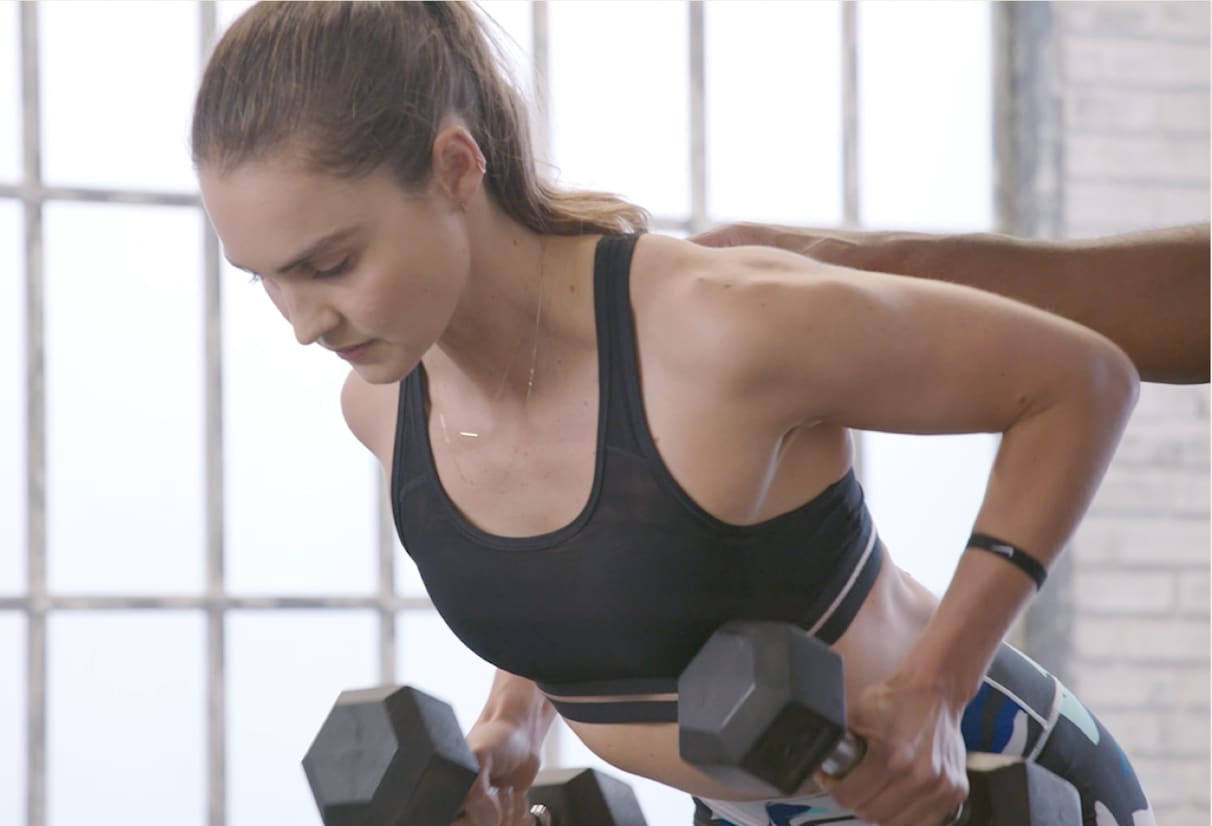Three Dumbbell Row Variations to Challenge Your Upper-Body Strength
Coaching
By Nike Training
Build your back and create dynamic strength with bent-over rows
Strength and balance are the key benefits of these shoulder-friendly pulling exercises. Bring in variation to maximise and balance muscle groups.
Want to correct imbalances from all the pushing and pressing you do, throw a ball with more explosiveness and boost your upper-body and grip strength for the gym and the real world? You should be doing bent-over rows. The move rivals pull-ups as one of the best exercises to build a strong, muscular back. While they're both compound pulling exercises, the horizontal position of the row is friendlier on your shoulder joints—not to mention much easier to execute.
Try these favourite variations on the classic strengthener from Nike Master Trainers Kirsty Godso and David Carson to row your way to max results.
Two Things to Do Before You Get Started
- Activate the muscles you're targeting.
To "turn on" your traps, lats, rear delts, rhomboids, biceps, hamstrings and erector spinae—all while lengthening the musculature in your chest—knock out a mobilisation drill. Try a couple of sets of dead lifts with light dumbbells, or grab a resistance band at each end and pull it apart slowly and with control. - Master the OG: the bent-over dumbbell row.
This is the foundation you'll build upon for any variation. Here's how to do it:
Stand with your feet hip-width apart and hold a dumbbell in each hand, arms by your sides. Hinge forwards 45 degrees from your hips with a flat back, core engaged, arms extended straight below your shoulders with palms facing inwards and knees slightly bent, to start. Bend your arms to pull your elbows straight back, tight to your sides, until the weights reach your torso, squeezing your shoulder blades together. Lower to return to the starting position. That's 1 rep. Repeat.
Three Dumbbell Row Variations to Try Now
01. Bent-Over Dumbbell Isometric Hold With Opposite Row
Muscles worked: traps, shoulders, chest, lats, rhomboids, biceps, erector spinae
Follow the same setup for the bent-over row. Then bend one arm to pull your elbow straight back, tight to your side, until the weight reaches your torso, to start. Hold this row position (the isometric hold) as you cycle through reps of a row with the other arm. The extended time under tension (TUT) ups the challenge on your muscles, improving their endurance. Do all reps on one side, then switch arms; repeat.
Make It Easier
If you're unable to hold the weight for the entire set, you can still increase your muscles' TUT by turning it into an eccentric row, where you pull the weights to your torso for 1 count, then lower for 3 to 5.
Make It Harder
Increase the weight or make the row eccentric. Row the dumbbell to your side, then slowly lower it back down for 3 to 5 counts. That's 1 rep. Repeat.

02. Reverse-Grip Row
Muscles worked: traps, shoulders, chest, lats, rhomboids, biceps, erector spinae
Follow the same setup for the bent-over row, but hold the weights with your palms facing upwards rather than inwards. This grip engages your lats and biceps more than the overhand grip does.
Make It Easier
Lighten the load and focus on spreading your collarbones apart, ensuring that you're initiating the movement by drawing back your scapula. Or alternate sets of your standard, neutral-grip rows with the reverse grip until it feels more comfortable.
Make It Harder
Use a barbell. Because you're lifting the bar from the ground, you'll work through a bigger range of motion, which allows you to target more muscle fibres. This grip makes it easier to keep your elbows tight to your sides, which lightens the load on your joints and allows you to lift heavier weights.

03. Bent-Over Alternating Row
Muscles worked: traps, shoulders, chest, lats, rhomboids, biceps, erector spinae
Follow the same setup for the bent-over row, to start. Then bend one arm to pull your elbow straight back, tight to your side, until the weight reaches your torso. Lower to return to the starting position. That's 1 rep. Switch arms; repeat.
Make It Easier
Use a bench for support. You can stand either perpendicular to it with your feet hip-width apart and hips square, or parallel to it with your feet staggered, with your non-working hand firmly on the bench.
Make It Harder
To increase the challenge to your core, perform a renegade row, which is basically an alternating row from a plank position. Come into a plank with a dumbbell in each hand directly under your shoulders and feet slightly wider than hip-width apart, to start. Bend one arm to pull your elbow straight back, tight to your side, until the weight reaches your torso. Lower to return to the starting position. Switch sides; repeat. That's 1 rep. If you're up for it, add a push-up between reps.

Train With Us
Tap into the ultimate training resource with the Nike Training Club App. From expertly designed workouts to holistic tips on nutrition, mindset, recovery and sleep, NTC has everything you need to perform your best.
Join Nike Training Club
Get access to our world-class experts and trainers for help staying active and healthy.

Join Nike Training Club
Get access to our world-class experts and trainers for help staying active and healthy.